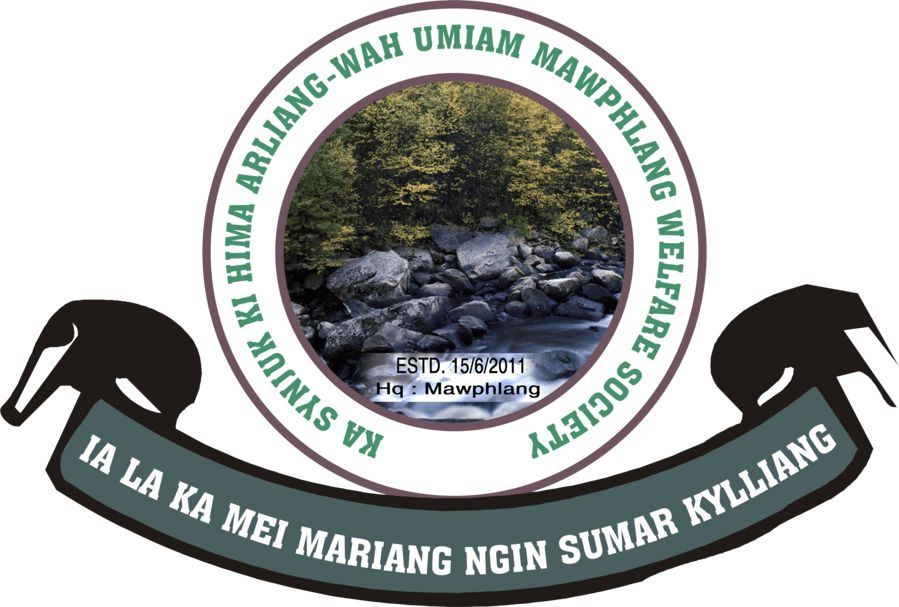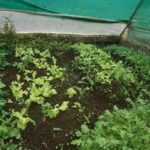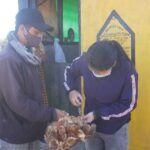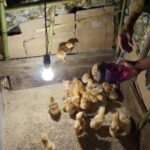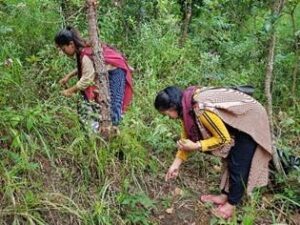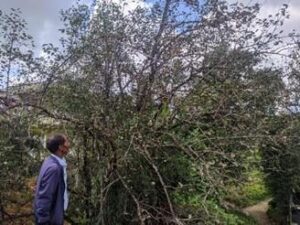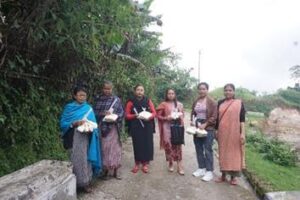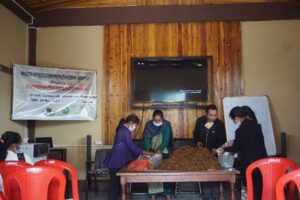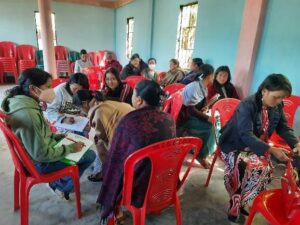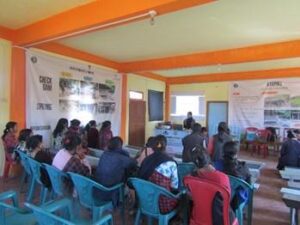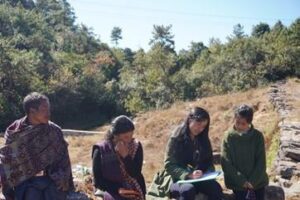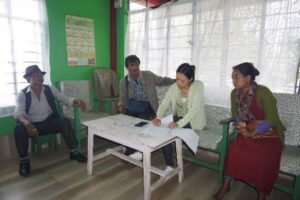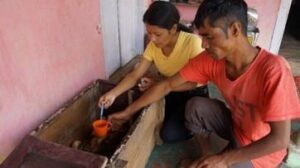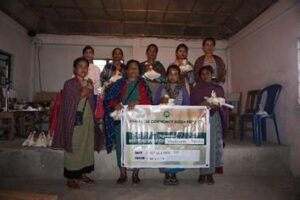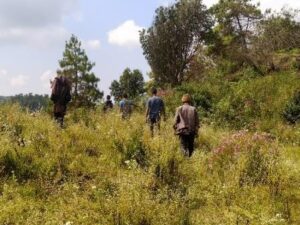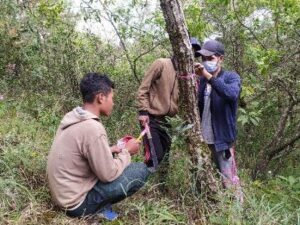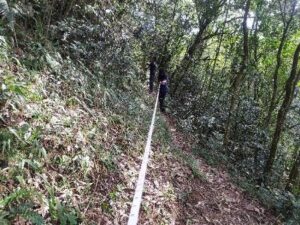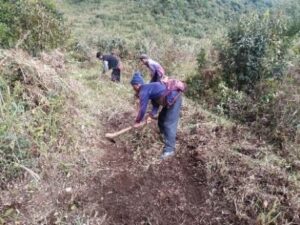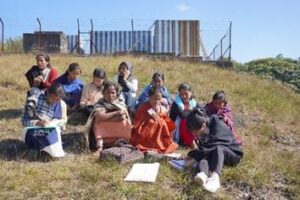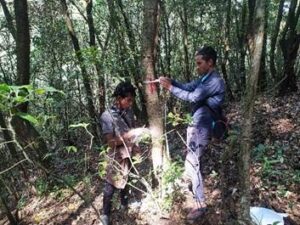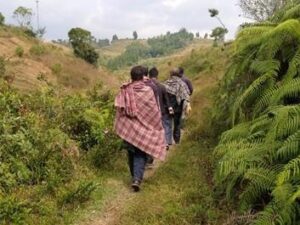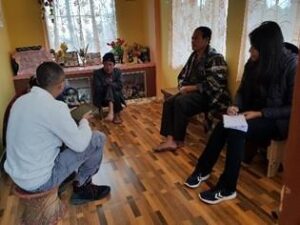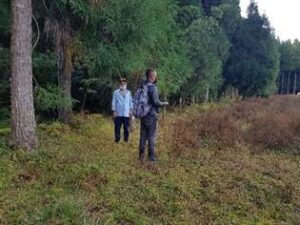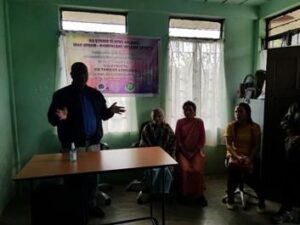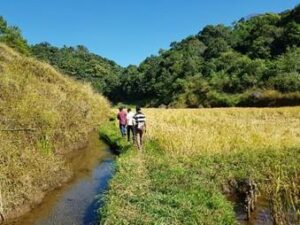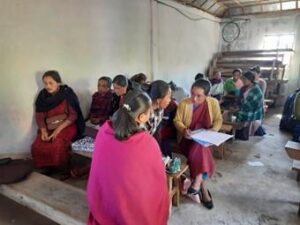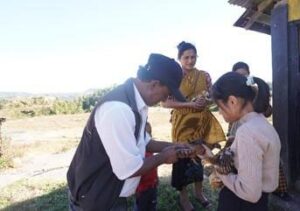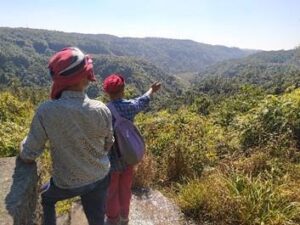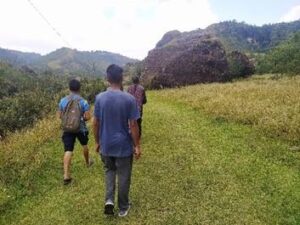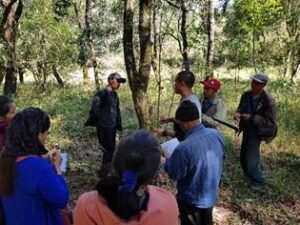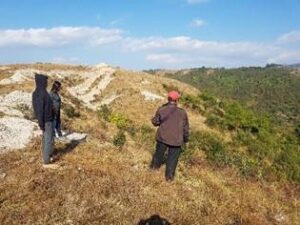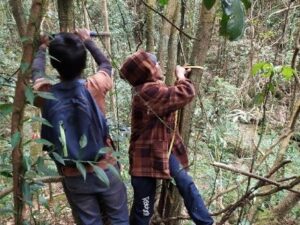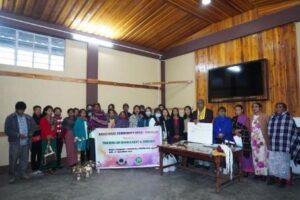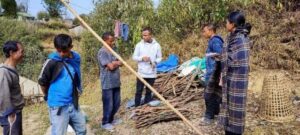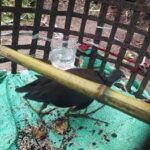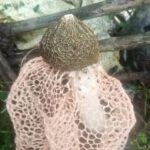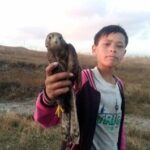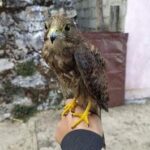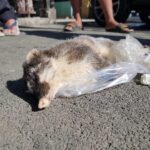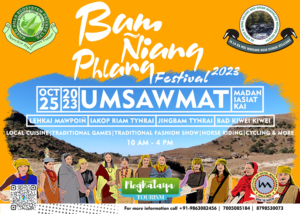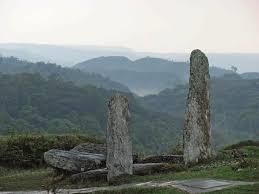
KHASI HILLS COMMUNITY PROJECT
4th Quarter Report Oct-dec 2021
PROJECT SUMMARY
The Khasi Hills Community Project has completed 10 years of successful operation. The project has mobilized approximately 7,250 families to protect and restore 2,847 hectares of old-growth, montane cloud forests in the Umiam River Watershed. In addition, project communities are working to regenerate nearly 9,000 hectares of degraded forest. In return for their efforts to save their community forests from logging, forest fires, mining, and conversion to agriculture, the project provides communities with a diverse set of social and economic activities. The project is reaching its goal of increasing household income as new village surveys show that 70 percent of the families are below India’s poverty line, compared to earlier numbers of 90 percent. The project also seeks to improve public health through the provision of clean drinking water systems and smokeless cooking technologies, such as LPG and rice cookers, to reduce household air pollution.
Response to COVID-19 Global Pandemic
The COVID-19 pandemic second wave lessened over the fourth quarter and most restrictions on travel and gatherings were lifted. Vaccination drives continue to be held throughout the state and second doses have been administered. During the fourth quarter of 2021, new daily covid cases in the state continued to decline and were down to the single digits per day toward the end of December. Community Facilitators (CFs) and Youth Volunteers have continued with forest patrols, monitoring, and distribution. The CFs also trained Youth Volunteers to assist in carbon plot monitoring. The team is in good communication with CFs prior to site visits to ensure the areas are safe and prepared. The project continues to distribute masks and practice distancing in efforts to reduce the spread of COVID-19. Testing and quarantining are practiced if symptoms in staff are detected.
Forest Habitat and Wildlife Conservation
Conserving the montane cloud forests along the steep banks of the Umiam River is a major goal of the project. The dense forests drop over 500 meters to the rushing waters of the river which subsequently flows into Bangladesh. The historic David Scott Trail constructed in the early 19th century, winds its way up the river gorge and has become a popular hiking route and tourist destination. Forest conservation is complemented by community efforts to restore forest fragments on the hill tops above the river, creating a wildlife corridor that extends from the 2,000-meter plateau down to the Bangladesh plains. This habitat supports a broad range of birdlife, reptiles, and mammals, as well as amphibians, fish, and orchids, some of which are found only in this area. During this quarter, several species of birds from border areas, including a hummingbird, were sighted in the project area. A shift has been seen in animals moving to higher altitude areas and inhabiting the wildlife corridors.
Awareness programmes continue to be held in new villages on a regular basis. During these programmes, the socio-economic team, forestry team and project director speak on the project activities and the benefits provided toward communities for conservation of forests and habitats. The village Headman and the Community Facilitators often lead the discussion and provide a platform for the project to communicate with community members.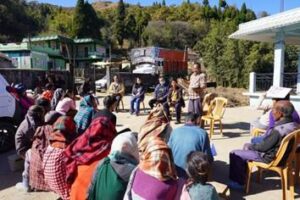
An important project strategy to reduce deforestation and forest degradation is community- based forest fire control. The project has continued to train local Community Facilitators in monitoring the production, transport, and use of charcoal within the project area. This fourth quarter is characterized by the beginning of the dry season. During this time fuelwood monitoring is performed and firelines are maintained.
Degraded Forest Restoration
With nearly 9,000 hectares of open forest land, the project seeks to restore these areas to improve wildlife habitat, increase the hydrological function of the watershed, and sequester atmospheric carbon. Each participating village identifies the degraded community forests that they want to restore and agrees to close the land to firewood collection, grazing, and agriculture. The villages receive support from the project to clear fire lines and remove weeds and scrub to open space for emerging saplings. Gaps are filled with native seedlings and saplings. Currently there are over 1,600 hectares being actively restored with Assisted Natural Regeneration (ANR) treatment. Villages are finding that restoring the watershed is resulting in better stream flow levels, as well as water availability in the dry season. In 2021, over 61,000 saplings (including nearly 6,000 saplings transplanted from forests) were planted by community members, youth volunteers, SHGs, and CFs in ANR areas, community forests, and land affected by forest fire.
Clean Energy Transition
Household firewood consumption for cooking and heating is a major driver of deforestation in the project area as well as contributing to indoor smoke pollution that causes respiratory illness. In addition, fuelwood burning also is a major source of carbon emissions. To address these problems, the project is working to supply all project families with LPG cooktops and LPG cylinders, or electric rice cookers. Previous surveys by the team found that adoption of gas cooktops has reduced firewood consumption an average of 2.5 kgs of fuelwood per day for each household. Fuelwood continues to be monitored by Youth Volunteers in the communities.
To get a better understanding of how families use fuel currently, including fuelwood and charcoal, the project is conducting ongoing surveys based on fuel needs and current arrangements. Through the surveys, the team found that those who had used the LPG found it to beneficial in cooking time and ease. However, one of the challenges is the distance and cost of refilling the cylinder. The surveys will also provide information on which families are already implementing LPG and which would like to do so in the future. The CFs play an important role in monitoring and following up on alternative energy practices.
Sustainable Agriculture
With most families dependent on farming for their income, improving agricultural practices has been a project priority. The project team seeks to assist families from a heavy dependence on low value potato cultivation to diversify into horticulture, polyhouse vegetable growing, and organic farming. After the project distributed polyhouses and shade nets, village families have been able to start cultivating a number of vegetables like mustard leaves, passion fruit, and chillies to generate income. SHGs are also involved with vermicomposting to increase value-added products to their marketable goods and for use in their own agricultural practices. During this quarter, vaccinations were given for poultry. Egg production has been a profitable venture, with one beneficiary selling 56 trays at Rs.350 per tray.
Eco-Tourism and Cultural Conservation
During the 4th quarter, eco-tourism sites began to open again to domestic tourists. Guides have been eager to share the cultural beauty with others once again and rely on this for their livelihood.
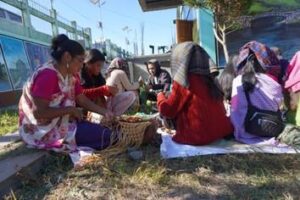 Thirteen communities have been using eco-tourism grants to build better facilities, hiking trails, and viewpoints during the lockdown in anticipation of future visitors. During this quarter, training on local handicrafts was conducted, including handcrafted bamboo and Coix lacryma-jobi earrings, woven tiffin bags, and decorative flowers made of bamboo and Coix lacryma-jobi.
Thirteen communities have been using eco-tourism grants to build better facilities, hiking trails, and viewpoints during the lockdown in anticipation of future visitors. During this quarter, training on local handicrafts was conducted, including handcrafted bamboo and Coix lacryma-jobi earrings, woven tiffin bags, and decorative flowers made of bamboo and Coix lacryma-jobi.
Community Horticulture
As part of the project’s sustainable agriculture program which includes organic farming techniques, vermiculture, and composting the project team is also providing high value fruit trees such as peach, plum, pear, apple, and pomegranates to project families. This helps diversify farm produce, especially low value, high input potato farming on which many families depend. Fruit trees also provide produce that can be converted to value-added jams, jellies, and pickles. The fruit trees are found to have a high survival rate when protected from grazing animals. During this quarter, fruit trees continued to be monitored by the Community Facilitators. Seeds were collected from Pyrus species for propagation. The forestry team monitored the plantation site of medicinal herbs which had been distributed and planted earlier in the year to increase the production of herbs used by local herbalists.
Mushroom Cultivation
The project continues to oversee a mushroom cultivation programme and has been expanding this high value production system given the conducive moist, high elevation environment. Oyster mushrooms bring in a good return for local families once the mushroom house has been constructed. During this quarter, the project distributed mushroom spawn to 42 beneficiaries and a trainer from the Mushroom Development Centre conducted a training on mushroom cultivation. Beneficiaries are able to sell the harvested mushrooms for Rs. 300/kg.
SHG FEDERATION
The project is currently in the process of forming an SHG Federation to improve and overcome the inherent limitations of small and informal groups, like limited resources, capacity, negotiation and bargaining powers and an inability to deal with the outside world such as Government, mainstream institutions, and markets. The project team has been organizing several awareness programmes about the Federation of SHGs. Lady Community Facilitators are also spreading awareness about the SHG Federation while meeting with SHGs in their respective Hima. During this quarter, the socio-economic team also held SHG assessments to determine how their skills have developed as well as to discuss any challenges or benefits to the groups.
Community Development Grants
Each year the project provides the participating communities with community development grants (CDG) to fund projects that benefit many village families. The villages prepare proposals for priority projects. Most communities use the funds for sanitation, water projects, and school upkeep. Lower Working Committees (LWCs) continue to meet, prepare village management plans, discuss finances, and oversee the implementation of grant-funded projects. During this quarter, the LWCs were assessed by the staff on their activities, budgets, initiatives, number of beneficiaries, and future plans.
Project Updates
- October 2021
- November 2021
- December 2021
1 October 2021
The Socio-economic Team (SET) administered an Infectious Bursal Diseases (IBD) vaccination to male chicks which had been distributed on 17 September 2021. 400 IBD vaccinations were given.
8 October 2021
The SET distributed mushroom spawn to 10 Hima with a total of 42 beneficiaries. Each beneficiary received 5 spawn.
9 October 2021
Site selection for mapping of ANR at Umsohjur, Mawbeh, Hima Mawbeh took place along with the CF, Asst. CF, Local Youth Volunteer, and the Executive Members of Mawbeh village. The proposed future ANR area is expected to be approximately 22 hectares.
11-15 October 2021
The project from the Khasi Hills visited the Churachandpur district of Manipur for reviewing the land use, landcover and socioeconomic status of the Kukis in the hill district of Churachanpur. A team of 5 from the Khasi Hills along with the NGO, Leimata Area Social Transmission Organisation (LASTO), visited three out of the five initial villages for the Kuki Community REDD+ Project. Awareness programmes, field visits, meetings, and Participatory Rural Appraisal (PRA) were conducted.
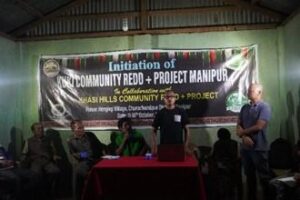
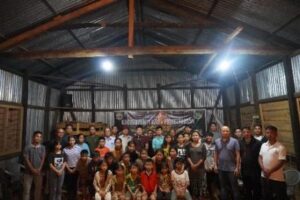
13 October 2021
The main carbon plot was laid along with its sub-plot at Lumlaitsohphoh, Wahlyngkien Ramklang, Mawphlang Lyngdohship along with the CF, Asst. CF, and the Youth Vounteers. The new plot is a replacement of an old plot which was destroyed by forest fire.
14 October 2021
A 10x10m plot was laid for monitoring species diversity at Syntung.
18 October 2021
Fireline monitoring was conducted at Thainthynroh, Lawlyngdoh, Lyngiong Lyngdohship with the Asst. CF of Hima Lyngiong. The activity was done by the Local Youth Volunteers of Hima Lyngiong and the total fireline length was 1.2km.
22 October 2021
The SET conducted SHG assessment at Umsawmat village, Thainthynroh village, and Perkseh village. A total of 48 members of 15 SHGs attended.
23 and 29 October 2021
The Forestry Team monitored the carbon plots of Hima Laitkroh; Weisawdong, Umlangmar of Hima Nongspung; and Laitsohpliah and Umdiengpoh of Hima Sohra along with the Local Youth Volunteers and CFs.
26 October 2021
ANR mapping at Steplakrai, Hima Mawbeh took place along with the CF, Asst. CF, and village members of Steplakrai at Lumpnon with a total area of 3.8 hectares.
28 October 2021
The team collected data on the village management map from the village of Mawmyrsiang and Tiewlieh under the Mawmyrsiang cluster.
30 October 2021
Mawjrong village was mapped as part of the village management plan.
3 November 2021
The new office was opened in Ri-Bhoi district as part of the extension programme in Bhoirymbong.
4 November 2021
Mapping took place in in Lummawkong village, Hima Laitkroh along with the CF and Executive Members.
5 November 2021
The Forestry Team visited the new extension area of Rangblang in Southwest Khasi Hills District. The clan of Sangriang has offered the Project the clan land for restoration programme.
5 and 9 November 2021
The SET conducted SHG Assessment at Tyrsad Umkseh Community Hall. A total of 14 SHGs and 23 attendees participated in the SHG Assessment. SHG Assessment was also conducted at Mission Compound Community Hall where there were 10 attendees including 6 SHGs.
9 November 2021
The SET gave Fowl Pox Vaccination to the chicks distributed on 14th and 17th September 2021.
11 November 2021
The Forestry Team conducted training on Home- based Nursery for the SHGs of Hima Lyngiong and Mylliem. Five SHGs and 11 participants were present during the training.
17 November 2021
The ANR of Law Adong, Rngidiengsai (20.5 Ha) was mapped by the Sordar of Rngidiengsai, CF, Asst. CF, and Youth Volunteer of Hima Sohra.
19 November 2021
Mapping of Wahsohjir ANR (21 Ha) took place at Mawbeh with the Sordar of Mawbeh, CF, Asst. CF, and Youth Volunteer of Hima Mawbeh.
November 2021
The Forestry Team along with CFs and Local Youth Volunteers monitored carbon plots of 12 locations throughout the month of November.
20 November 2021
The Forestry Team mapped the new ANR area of Kyrphei village.
1, 3, 15, 16 December 2021
The carbon plots were laid at Ur Ur Community Forest, Ur-Ur village, Hima Mawphlang; Laitsohum Community Forest, Laitsohum village, Hima Nonglwai; Wahrahaw Community Forest, Wahrahaw village, Hima Mawphlang; and Lum-ban-um at Laitmawpen, Hima Mawphlang. The Forestry Team along with the respective CFs, Asst. CFs and Local Youth Volunteers of the Hima assisted.
2 December 2021
The SET organised a training on handicraft and jewellery at the Community Resource Knowledge Centre. Those in attendance were divided into groups where different activities were given to each group. Groups were trained on making handmade bamboo earrings, woollen crochet tiffin bags and decorative flowers through the use of sohriu (Coix lacryma-jobi) and bamboo.
11 December 2021
The team trained the new CFs of Hima Nongspung and Hima Lyngiong on fuelwood monitoring. The monitoring was started again in the month of December.
Biodiversity Monitoring
During the 4th quarter of 2021, a heron was rescued and rehabilitated in Mawphlang, Nongrum. A veiled mushroom was spotted in Mawkma village. An injured falcon was rescued from Mawphlang by cow herders and handed over to the Wildlife Department of Meghalaya to release back into the wild. A ferret badger was found dead by the local youth of Nongrum village, and it was handed over to the Wildlife Department to determine the cause of death. The autopsy report ascertained a natural death. A hummingbird was spotted at Lumkor. Birds which are native only in the Ri-War area were also found in Lawlyngdoh Khon forest for the first time in Mawphlang. GPS coordinates of the location have been identified.
